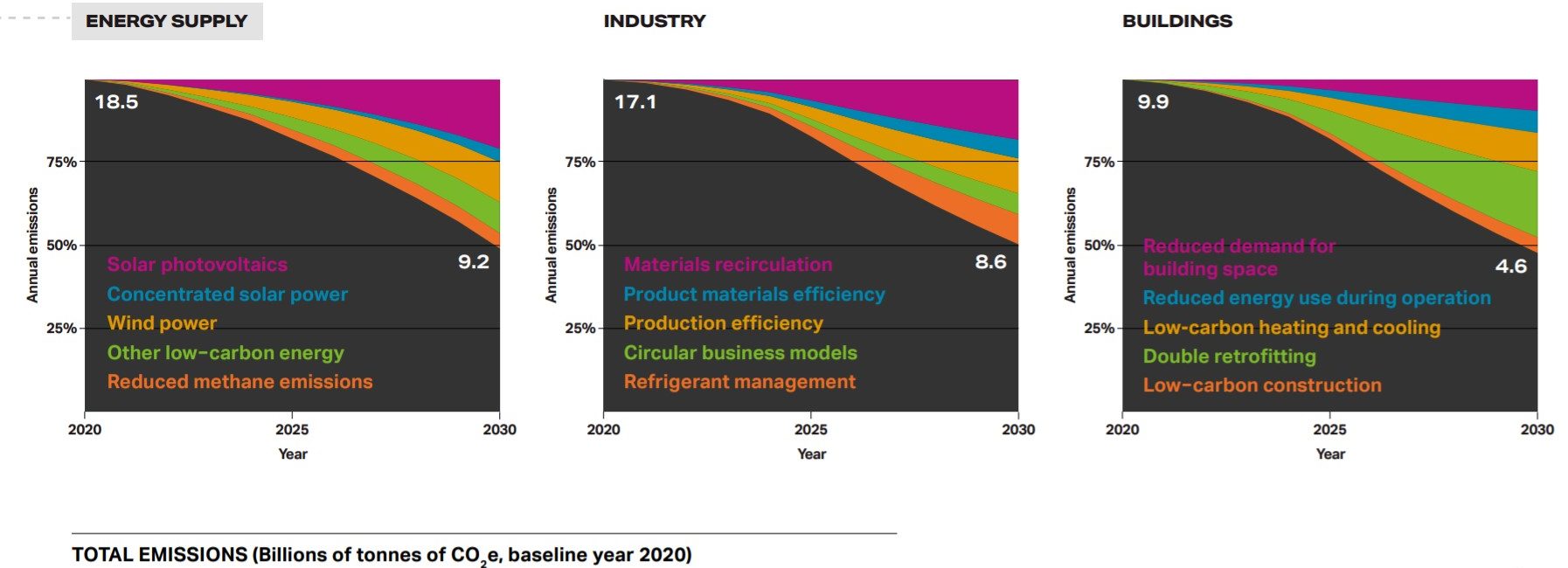These solutions will help us halve our emissions by 2030
 6 Oktober 2019
6 Oktober 2019
Curbing CO2 emissions is a clear necessity but no silver bullet exists to get our emissions down fast. Yet there is a silver shot of 36 pellets, according to a new report.
The Exponential Roadmap: the 36 most viable solutions to halve greenhouse gas emissions globally by 2030 comes from 55 authors, including academics, industry players, policy wonks, and consultants. A 50% reduction target will also ensure we are on track to net-zero emissions by 2050, which is considered crucial for achieving the goals set out by the Paris Agreement.
Energy, as the most carbon-intensive sector, can get its emissions from 18.5 Gt CO2e to 9.2 Gt CO2e with a transition to solar photovoltaics and wind energy responsible for over half of the results. Concentrated solar, other low-carbon tech and reduced methane emissions should account for the rest within the energy sector.
Meanwhile, for the industry, getting emissions from 17.1 Gt CO2e to 8.6 Gt CO2e will be possible through material recirculation, greater material and production efficiency, circular business models and refrigerant management. The authors consider a circular economy crucial for accelerating the transition. Another recent report suggests it can secure 45% of emission reductions by 2050 across all sectors.

Other sectors that will contribute to the transition include greener buildings (double retrofitting, low-carbon heating and cooling, etc.), transport, food consumption, and nature-based sources and sinks. Prominently, nature-based sources can help to avoid emissions of 3.5 Gt CO2e by 2030. New nature-based sinks can also store 9.1 Gt CO2e by 2030.
Among other key measures are the spread of mass transit, cycling, and electric vehicles, together with a number of other initiatives contributing to the reduction of emissions by over 4 Gt CO2e. The full list of 36 solutions can be found in the report, which also questions many common assumptions such as the expectation for rising energy demand. “Global energy demand has the potential to fall 40% without sacrificing services and quality of life according to new energy scenarios,” the authors say.
According to a co-author of the report, Brent Loken from the EAT Foundation, “Food and agriculture is the dark horse in the fight against climate change. It may be the hardest sector to rapidly halve emissions”, considering how much it depends on changes in people’s lifestyles.
Along with the offered solutions, the roadmap outlines four tipping points that can help to speed up the transition. It starts with the growing influence of social movements, cities, and companies on shifting the conversation towards more ambitious and devoted action. On a parallel track comes increasing devotion on the national scale, which has so far been limited to just a few leading states like the UK, Norway, Sweden and other states that have committed to reaching net-zero emissions by 2050 or earlier.
The third potential tipping point, according to the authors, is that renewables are quickly becoming cheaper than fossil-based energy thanks to innovations in energy storage and the expansion of the EV market. Finally, digitalization can help upscale and speed up all these efforts.
While 2030 has been set as a common baseline for halving emissions, the authors suggest that the forerunners among companies and cities will be able to achieve the goal much sooner. Still, global emissions peak should be reached by 2020. The report suggests that a low-carbon future can bring over $26 trillion in benefits, as compared to a high-carbon pathway.
Still, as the report notes, currently there is a 90% probability that we will exceed the less optimistic 2°C warming target based on what countries have promised and a 97% probability of us exceeding this target based on what they are actually doing. We have 0 years left to peak emissions and this means we’ll need to act now.
The post These solutions will help us halve our emissions by 2030 appeared first on Sustainability Times.
